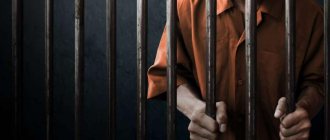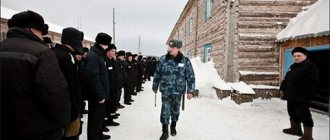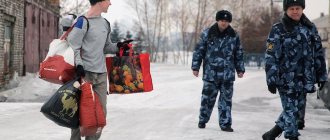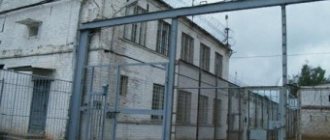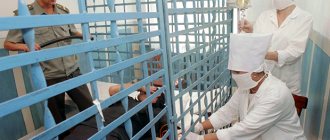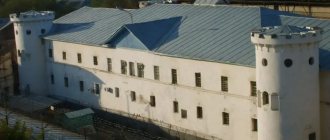Russia has experienced a huge number of upheavals over the past hundred years. Revolution, war, “hunger years”, years of stagnation, perestroika, redistribution of property, gangster 90s... During the time of Stalinist repressions, millions of people were in camps; after the war, all those captured were recognized as enemies of the Soviet state and were sent to a new stage; in the 90s, people tried to survive as best they could, many went into racketeering, and with the advent of legality they were sent to prison zones. As a result, by the beginning of the 21st century, prison life affected almost every family - if the person himself was not in prison, then among his relatives or friends there was always someone who had visited places not so distant. Finding a family now that does not have such a skeleton in their closet - among brothers, uncles, distant relatives or friends - is extremely difficult.
First option for zone classification
The first classification gives us the following definition of what the red zone is. According to this classification, zones differ in their population. The Red Zone is a correctional colony for former law enforcement officers. The black zone is a colony where civilians serve their sentences. Red zones in Russia according to this classification are intended not only for former police officers, but also for prosecutors, military personnel, employees of the Investigative Committee, bailiffs, and jailers. Putting them in the same cell with the contingent that they themselves brought to justice only means increasing crime in the colonies.
Which zones in Russia are “red” according to this classification? Former law enforcement officers serve their sentences in the following places:
- Nizhny Tagil, Sverdlovsk region, IK-13.
- G. Bor, Nizhny Novgorod region, Borsky district, IK-11.
- G. Skopin, microdistrict Oktyabrsky, Ryazan region, IK-3.
- G. Engels, Industrial zone, Saratov region, IK-13.
- Pechora town, Misha-Yag village, Komi Republic, IK-49.
- Republic of Mordovia, Zubovo-Polyansky district, Leplei village, IK-5.
- Irkutsk, IK-3.
Were there any “whites”?
The color white also first appeared during the French Revolution, with white lilies on the royal coat of arms. But the Russian “White Guards” were not supporters of the monarchy. Rather, they wanted to establish their own system - bourgeois, democratic.
However, in 1917, a crowd wearing white armbands marched against the Bolsheviks.
There is also a version that the “white guard” was the name given to the bourgeois police in Finland, created in 1906, and those who opposed them called themselves the “red guard”.
But, according to some sources, the “White Guards” themselves did not call themselves white during the Civil War. Later, in exile, the Russian elite in exile considered itself the “white bone” of Russia, and then the “white” movement.
Second example of zone classification
Nowadays, another meaning is increasingly used when dividing colonies by color. What is the red zone according to this classification? This is a colony where the administration and activists “run the show.” Here, interaction between prisoners and the zone administration is encouraged. Thieving traditions are strong in the “black” zone; in parallel with the administration, there is a strong “institution of overseers”; life is built on prison laws.
What is the difference between the red zone and the black zone? Features:
- Power lies with the “activists” and the administration.
- There is no free circulation of alcohol and drugs.
- The prisoners are busy working and do not hang around idle.
- It is customary to greet every employee.
What it is?
A “red” prison is one in which the law rules. There is not the slightest deviation from state documents.
Everything is as per the instructions. It often happens that in the “red” zones, prisoners cooperate with prison employees. In such detention centers, the law is executed with meticulousness, which sometimes becomes more difficult for the prisoners than the punishment itself, because... for the slightest disobedience they will face very serious punishment from the jailers and other representatives of the prison authorities. The administration of the correctional institution does not see the limits of its power, so punishments often include isolation in solitary confinement, deprivation of any rights (they may be deprived of a walk, lunch, etc.), and sometimes beatings.
Conditions of detention in a colony-settlement
The mildest type of punishment associated with imprisonment. Those sentenced to a term not exceeding 5 years are held here for crimes committed through negligence. Also, those prisoners who have proven themselves well in general and maximum security colonies are transferred here.
In a colony-settlement there is no strict security; here the concept of “under supervision” is more used. Convicts have the right to move without restrictions within the territory of the colony from waking up to bedtime. They are allowed to wear civilian clothes, receive parcels, use pocket money without restrictions, and receive visits. They live not in cells, but in dormitories. Moreover, if a convict has a family that would like to live with him, then this is not prohibited by the colony administration. Families are allowed to live in rented housing on the territory of the colony. But we must understand that this is not a resort; the administration of the colony settlement has the right to check such housing at any time of the day.
The work of such convicts is paid in accordance with labor regulations. And if you want, you can even get an education, but only in absentia and within the boundaries of the administrative-territorial entity.
Orders in the “red” zones
One of the biggest fears of “correct” criminals is ending up in a “red” colony. There, order and discipline are maintained by prisoners collaborating with the colony administration. For this they receive certain relaxations in the regime. In addition, inside the “red” prison itself there is also a division into sections. For example, prisoners are assigned to the law enforcement, sports, or hygiene and cleanliness sections. Failure to comply with section rules usually results in severe penalties.
In most “red” prisons, arbitrariness reigns on the part of the administration. The slightest offense - an untimely smoke break or a swear word during a round - and the prisoner can end up in a punishment cell. Or they will use other methods of punishment, including assault. They learn about all violations in the administration only from informers - “goats”. And even thieves in law who find themselves in the “red” zone cannot fight them. Here, unlike other prisons, they have no authority. Moreover, thieves in law are often transferred to “red” colonies in order to break their will. They are forced to break the thieves' code and work for the administration. Some agree to cooperate voluntarily, but many have to be broken long and hard.
In the “black” prisons of Russia, completely different laws reign. They are run by thieves in law.
Conditions of detention in a general regime colony
Here are those convicted of serious crimes, if this crime was committed for the first time. The second category is those convicted of crimes of minor and medium gravity, if the court found it impossible to reform in the conditions of a colony-settlement. And one more category - convicts who have reached the age of 18, who served their sentence in a correctional colony until they came of age. There are general regime colonies for both women and men.
Conditions here are harsher than in the settlements. Less freedom, more restrictions. They live in locked rooms. There are workdays: 8 hours of work, an hour break for lunch, according to the Labor Code of the Russian Federation. The number of dates is limited - 6 short-term and 4 long-term per year. The number of parcels is also limited - only six for the same period.
In general regime colonies there is also the opportunity to get an education and participate in cultural and sports events. Management, as a rule, creates all the conditions for this.
Establishment of "red" power
As we said above, the tragedy of the Civil War began long before the October Revolution. The common people, soldiers, workers and peasants were dissatisfied with the current situation. If in the central regions many paramilitary detachments were under the close control of Headquarters, then in the eastern detachments a completely different mood reigned.
It was the presence of a large number of reserve troops and their reluctance to enter into a war with Germany that helped the Bolsheviks quickly and bloodlessly receive the support of almost two-thirds of the army. Only 15 large cities resisted the “red” authorities, while 84 passed into their hands on their own initiative.
An unexpected surprise for the Bolsheviks in the form of stunning support from confused and tired soldiers was declared by the “Reds” as a “triumphant procession of the Soviets.”
The civil war (1917-1922) only worsened after the signing of the Brest-Litovsk Peace Treaty, which was devastating for Russia. Under the terms of the treaty, the former empire lost more than a million square kilometers of territory. These included: the Baltic states, Belarus, Ukraine, the Caucasus, Romania, Don territories. In addition, they had to pay Germany six billion marks of indemnity.
This decision caused protest both within the country and from the Entente. Simultaneously with the intensification of various local conflicts, military intervention by Western states on Russian territory begins.
The entry of Entente troops was reinforced by the uprising of the Czechoslovak corps in Siberia and the revolt of the Kuban Cossacks under the leadership of General Krasnov. The defeated detachments of the White Guards and some interventionists went to Central Asia and continued the struggle against Soviet power for many years.
Conditions of detention in a maximum security colony
Persons whom the court considered the most dangerous to society and, accordingly, require strict isolation are kept here. These are those who have committed, for example, the intentional murder of two or more people or a contract killing. They also end up in such a colony for recidivism.
Convicts are kept in locked cells. Beds are in two or three tiers; an area of no more than 7 m² is allocated per prisoner. 4 parcels and 4 parcels per year are allowed; three long and three short dates. You cannot spend more than 2 minimum wages on food in the colony stores.
And, of course, the main difference is the contingent. In a maximum security colony, a “first mover” is a rarity. Most of those convicted are those who chose a life of crime as their life credo.
Prerequisites for the war
When studying the Civil War in class, a table is essential for a good understanding of the material.
Below are the stages of this military conflict, which will help you better navigate not only the article, but also this period in the history of the Fatherland. Stages of military conflict
| Stages | Dates | Events |
| 1 | February–March 1917 | Overthrow of autocracy, division of society. |
| 2 | March–October 1917 | Intensification of confrontation in society. |
| 3 | October 1917–March 1918 | Liquidation of the Provisional Government. Establishment of Soviet power. The spread of armed conflict. |
| 4 | March–June 1918 | Increase in violence and terror. Formation of the Red Army and the White. |
| 5 | Summer 1918 - end of 1920 | A war involving regular troops, including foreign ones. Militarization of the economy. |
| 6 | 1921–1922 | Attenuation, localization and end of the Civil War. |
Now that we have decided who the “reds” and “whites” are, the Civil War, or rather its stages, will be more understandable. You can begin to study them in more depth. It's worth starting with the premises.
So, the main reason for such intense passions, which later resulted in a five-year Civil War, was the accumulated contradictions and problems.
First, the Russian Empire's involvement in World War I destroyed the economy and depleted the country's resources. The bulk of the male population was in the army, agriculture and urban industry fell into decay. The soldiers were tired of fighting for other people's ideals when there were hungry families at home.
The second reason was agricultural and industrial issues. There were too many peasants and workers who lived below the poverty line. The Bolsheviks took full advantage of this.
In order to turn participation in the world war into an inter-class struggle, certain steps were taken.
First, the first wave of nationalization of enterprises, banks, and lands took place. Then the Brest-Litovsk Treaty was signed, which plunged Russia into the abyss of complete ruin. Against the backdrop of general devastation, the Red Army men carried out terror in order to stay in power.
To justify their behavior, they built an ideology of struggle against the White Guards and interventionists.
Conditions of detention in a special regime colony
People don’t end up here by accident, “by stupidity” or “by negligence.” It contains those criminal elements who have clearly been recognized as dangerous to society and who should not be among free people. Special regime colonies are colonies for those sentenced to life, for those sentenced to death, but who received a commutation of death by life imprisonment, and for those sentenced to 25 years - in practice, few of them survive to the end of their sentence.
Why can you end up in a special regime colony? These are the crimes that make the hair on the back of an ordinary law-abiding citizen stand on end. These are serial murders, serial rapes, terrorist attacks. Here sit cannibals and maniacs, sadists and fanatics. A prisoner who has committed a particularly serious crime while serving time in another colony can also end up here.
In colonies marked “special regime” there is no place for minors, women and men who have reached the age of 65 - the conditions for serving their sentences are too strict.
There are seven such colonies in Russia. Each has its own unofficial name: “Black Golden Eagle”, “White Swan”, “Vologda Pyatak”, “Torbeevsky Polar Owl”, “Mordovian Colony” and “Black Dolphin”. The living conditions can be examined in more detail using a specific example of the Black Dolphin colony.
"Correct" prisons
All criminals know that deviating from the laws of thieves faces a terrible retribution. Therefore, in the “black” colonies there is peace and grace for everyone who follows these laws. The authorities in power do everything possible to ensure that their “wards” have a good life. They establish a connection with the will, and for special merits they can even smuggle a cell phone into the zone. The administration turns a blind eye to prohibited things, alcohol and drugs in “black” prisons.
They also turn a blind eye to the fact that prisoners do not carry out the work assigned to them. For example, in the “black” zone, prisoners do not clean the area and refuse to wash their cells. However, this is a small price to pay for the fact that in the “black” colonies there are practically no murders or fights, unlike the “red” and “green” zones. Today there are fewer and fewer “black” prisons. But on the contrary, there have been more “greens” over the past few years. And the orders in them are somewhat different from the zones of other colors.
"Black Dolphin": a prison for lifers
Correctional Colony No. 6 of the Office of the Federal Penitentiary Service for the Orenburg Region (official name) owes its poetic name to the fountain with a sculpture of a black dolphin located in the courtyard of the institution. This prison can house 1,600 inmates. Currently, 863 people are serving sentences there. The number of prison staff is even higher - 900 people. The administration of the colony strictly maintains security. Such precautions bear fruit - no one has ever escaped from this place.
The Black Dolphin prison for lifers is famous for its strict daily routine and harsh rules for keeping prisoners. Random people don't end up there - this prison is intended for the most hardened criminals. So, for example, Vladimir Nikolaev, a famous Russian cannibal, who in the 90s killed two of his drinking buddies and used their meat as food, is serving his sentence there. Nikolai Astanov will sit there until the end of his days - he killed an entire family and burned their bodies in the forest. The lives of these criminals and other non-humans are built according to a single algorithm, day after day, year after year:
- Rise at 6 am. From this moment until lights out, prisoners are prohibited from sitting or lying on their bunks.
- The size of the chambers is 4 x 5 square meters. m. In such a “cage” there are one or two prisoners. The “neighbors” are selected by a psychologist.
- Impossibility of being left alone: prisoners are monitored 24 hours a day, 7 days a week. It is forbidden to cover your head with a blanket. The duty officer comes by every 15 minutes.
- When transferred from a cell to other rooms, prisoners are blindfolded to disorientate them. They move bent over to eliminate the possibility of escape.
- There is no dining room here. Food is pushed through holes in the doors. The menu is not very varied - porridge, soup, bread.
- Every day, an hour and a half - a walk in the fresh air, in any weather. At this time, the administration checks the cameras for the presence of prohibited items.
“Black Dolphin” is not a prison where people end up “just like that,” having lost their way, through stupidity or misunderstanding. These prisoners are responsible for a truly enormous number of crimes. The number of lives that these 800-plus people took is more than 3,500. 4 lives for each criminal. Scary numbers.
October Revolution
In fact, the tragedy of the Civil War begins with the October Revolution. The Bolsheviks were gaining strength and moving more confidently to power. In mid-October 1917, a very tense situation began to develop in Petrograd.
October 25 Alexander Kerensky, head of the Provisional Government, leaves Petrograd for Pskov for help. He personally assesses the events in the city as an uprising.
In Pskov, he asks General Dukhonin to help him with troops. Kerensky seems to be receiving support from the Cossacks, but suddenly the cadets leave the regular army. Now constitutional democrats refuse to support the head of government.
Not finding adequate support in Pskov, Alexander Fedorovich goes to the city of Ostrov, where he meets with General Krasnov. At the same time, the Winter Palace was stormed in Petrograd. In Soviet history, this event is presented as key. But in fact it happened without resistance from the deputies.
After a blank shot from the cruiser Aurora, sailors, soldiers and workers approached the palace and arrested all members of the Provisional Government present there. In addition, the Second Congress of Soviets took place, where a number of major declarations were adopted and executions at the front were abolished.
In view of the coup, Krasnov decides to provide assistance to Alexander Kerensky. On October 26, a cavalry detachment of seven hundred people leaves towards Petrograd. It was assumed that in the city itself they would be supported by an uprising by the cadets. But it was suppressed by the Bolsheviks.
In the current situation, it became clear that the Provisional Government no longer had power. Kerensky fled, General Krasnov negotiated with the Bolsheviks the opportunity to return to Ostrov with his detachment without hindrance.
Meanwhile, the Socialist Revolutionaries begin a radical struggle against the Bolsheviks, who, in their opinion, have acquired greater power. The response to the murders of some “red” leaders was terror by the Bolsheviks, and the Civil War (1917-1922) began. Let us now consider further events.
Mode. “All movements are running, head down”
The abuse in the colony began immediately after the convoy of convicts arrived at the institution. “At the first moment of arrival, there are practically no administration employees; for example, there is one inspector from the security department. And the prisoners do the rest: they inspect the convicts, take away all their belongings, leave behind their underpants and socks, nothing else. The employees don’t do anything, they stand and are present,” Stanislav Rostov told employees of the “Committee for the Prevention of Torture” in an interview.
According to him, at first the search of the “transport prisoners” was carried out in the punishment cell, and there “everything happens in a civilized and polite manner.” “An administration employee is simply present there, he is not interested, he looks out the window... The survey of the prisoners, the entry in the journals, where they were born, who they worked for, the article, the term - everything is recorded by the convicts,” Rostov recalled.
After that, they were transferred to quarantine - the room where all new arrivals are initially kept.
Rostov says: “We go into quarantine, that is, we run, all movements must occur while running. Well, it reminded me, I saw a movie there, about a special regime, that is, we run into the cell, hands behind our backs like that, all movements are running, head down.” It was in quarantine that Rostov was beaten for the first time - for smiling at a fellow countryman he met.
Photo: Vitaly Nevar / TASS
“They beat everyone, absolutely. There wasn’t a single person there without being beaten,” he recalls his arrival at IK-14. Prisoner Yegor Podosinov (name changed), who was a night orderly in quarantine, said that with the knowledge and approval of the administration, the local supply manager and his assistants “mocked all the newly arrived convicts” and “didn’t let anyone through.” According to him, those who held themselves proudly and showed character were not just beaten: they had their arms and legs wrapped in tape, beaten on the heels with a stick, and “they shoved the handle of a shovel between their legs and between their buttocks.”
“With this method, prisoners are turned into animals, driven by the feeling of the herd instinct and not having their own right to vote and personal opinion. Punitive methods, torture and torment became the system of educational work of the head of BioOR (security and operational work - MZ) Voloshin V.S., aimed at correcting the convicted and unquestioning fulfillment of any whims,” another prisoner Nikita wrote in a statement addressed to the head of the Investigative Committee Bastrykin Nikiforov.
From all the convicts, activists demanded a statement of cooperation with the administration and a statement that they had no complaints against other convicts and employees of IK-14. According to Nikiforov, the text of the standard statement specified that in the event of complaints, the prisoners themselves “ask to be transferred to the category of the offended” - this fact was confirmed by other convicts. In addition, all those who arrived in the colony were forced to confess to fictitious crimes, which, according to prisoners, activists helped them write. Judging by the fact that no criminal cases were initiated or investigated based on these appearances, these papers were also kept in case of future complaints.
“Everyone says hello, strict adherence to the daily routine, getting up on time, going out on time, 100% turnout for breakfast, lunch, dinner, if you go for a walk, then go for a walk, and it doesn’t matter that the frost is minus 30, the walk is supposed to be two hours, and everyone will be at street. I saw something similar in the disciplinary battalion, we have the only one left in Russia, it is located in our region and in the sphere of our POC. And this is somewhat similar - convicts are always busy with something. There is zero free time,” Oleg Khabibrakhmanov says about the regime in IK-14.
Mandatory morning exercises. To the dining room - we line up again and run. “You have to sit down together in unison, on command. The command is pronounced by the senior orderly of the detachment. They took off their hats and sat down. Everyone must sit down in unison, at the same time. If someone sat down at the wrong time, then they will talk to him separately there later,” recalls former prisoner Rostov. For the entire meal, he says, five minutes are allotted: “You have to eat this plate in five minutes. Eat a plate of the first, a plate of the second and run.”
Three times a day - cleaning in the detachment. ""Come on lively! I got the soap here, run!” If you refuse something, he (activist - MZ) beats you. Well, a slap on the head, a kick in the ass, that’s normal. “Run! Come on, let's go clean the toilet! Come on quickly!” says Rostov. You cannot communicate with each other at this time. Those who object are beaten.
“They beat me on my heels with a stick. The rest of the convicts held me so that I would not escape,” recalled prisoner Podosinov. He and other victims say that beatings with a one and a half liter bottle filled with water were also practiced - on the head, neck, body; the bottle does not leave bruises.
Another method of punishment: pour cold water over it and leave it in the cold. Activist Molotov retells a conversation between two of his “colleagues” about a prisoner whom they mocked: “Oleg (name changed - MZ) said that I poured cold water on him for an hour, he passed out. He's sleeping now, I threw rags at him. He comes to his senses. I had one that stayed in cold water for four hours, then slept for a day. Rasul asked who are you? Oleg replied, “Yes, there’s only one EPKateshnik.” EPKT is a single cell-type room where the administration of the colonies sends persistent violators. The inmate in question died. Molotov says: “After some time, Rasul said that this ******* Oleg went too far, Stepanych decides, and he has old bruises. In general, hemorrhoids are small.”
“Basically, physical violence was used in the colony to maintain order. So that people immediately know their place. So that people don’t even think about complaining and walk in formation, greeting everyone on the count of one-two-three,” says Khabibrakhmanov. According to him, torture served not only as punishment for violating order - in the same way, confessions were extracted from prisoners who had not yet been convicted in the colony.
Reasons for victory
Let's figure out why the “whites” were defeated in the Civil War. We will compare the assessments of the opposing camps and try to come to a common conclusion.
Soviet historians saw the main reason for their victory in the fact that there was massive support from the oppressed sections of society. Particular emphasis was placed on those who suffered as a result of the 1905 revolution. Because they unconditionally went over to the side of the Bolsheviks.
“Whites,” on the contrary, complained about the lack of human and material resources. In occupied territories with a population of millions, they could not carry out even the minimum mobilization to replenish their ranks.
Particularly interesting are the statistics provided by the Civil War.
“Reds” and “Whites” (the table below) especially suffered from desertion. Unbearable living conditions, as well as the lack of clear goals, made themselves felt. The data concerns only the Bolshevik forces, since the White Guard records did not preserve clear figures. Deserters in the Red Army in 1919
| Month | Number of persons |
| February | More than 26 thousand. |
| March | More than 54 thousand. |
| May | More than 78 thousand. |
| June | More than 146 thousand. |
| July | More than 270 thousand. |
| August | More than 299 thousand. |
The main point that modern historians note was the political sphere of the conflict.
The White Guards, firstly, had no centralized command and minimal cooperation between units. They fought locally, each for their own interests. The second feature was the absence of political workers and a clear program. These aspects were often assigned to officers who only knew how to fight, but not how to conduct diplomatic negotiations.
The Red Army soldiers created a powerful ideological network. A clear system of concepts was developed that was drummed into the heads of workers and soldiers. The slogans made it possible for even the most downtrodden peasant to understand what he was going to fight for.
It was this policy that allowed the Bolsheviks to receive maximum support from the population.
The final stage
Historians tend to associate the beginning of the last period of the war of 1917–1922 with the Polish War. With the help of his western neighbors, Piłsudski wanted to create a confederation with territory from the Baltic to the Black Sea. But his aspirations were not destined to come true. The armies of the Civil War, led by Egorov and Tukhachevsky, fought their way deep into Western Ukraine and reached the Polish border.
Victory over this enemy was supposed to rouse the workers in Europe to fight. But all the plans of the Red Army leaders failed after a crushing defeat in the battle, which was preserved under the name “Miracle on the Vistula.”
After the conclusion of a peace treaty between the Soviets and Poland, disagreements begin in the Entente camp. As a result, funding for the “white” movement decreased, and the Civil War in Russia began to decline.
In the early 1920s, similar changes in the foreign policies of Western states led to the recognition of the Soviet Union by most countries.
The heroes of the Civil War of the final period fought against Wrangel in Ukraine, the interventionists in the Caucasus and Central Asia, in Siberia. Among the particularly distinguished commanders, Tukhachevsky, Blucher, Frunze and some others should be noted.
Thus, as a result of five years of bloody battles, a new state was formed on the territory of the Russian Empire. Subsequently, it became the second superpower, whose only rival was the United States.
Login to the site
In Russia there are two famous zones, known throughout the former USSR, and even abroad. These are the Orenburg “Black Dolphin” and the “White Swan” in Solikamsk.
The White Swan colony debunked the myth about the beautiful and free life of thieves in prison. Dozens, hundreds of thieves in law were “unthrown” here.
Today, within these walls there is one of the Russian “life-long” zones, as well as colonies of strict and special regimes. The last days of Salman Raduev passed here.
On January 5, 2008, the famous colony “BL”, as well as other colonies that were part of the Administration of Usol Camps (Usollag), celebrated their 70th anniversary.
Today our readers have the opportunity to learn about the “White Swan” from the mouth of the head of the Federal State Institution OIK-2 of the Federal Penitentiary Service of Russia in the Perm Territory, Colonel of the Ministry of Internal Affairs [2] Ashot Sargsyan.
